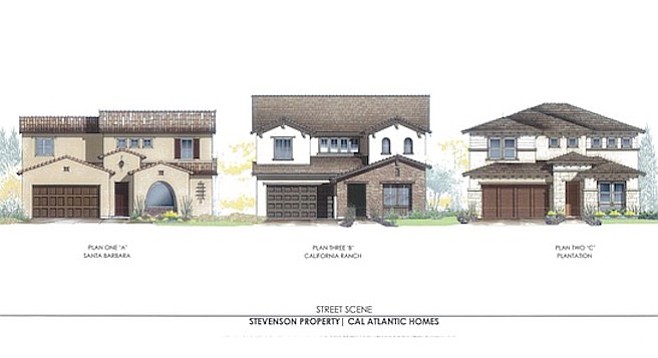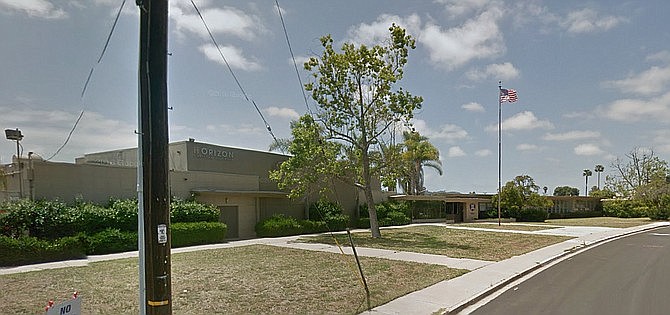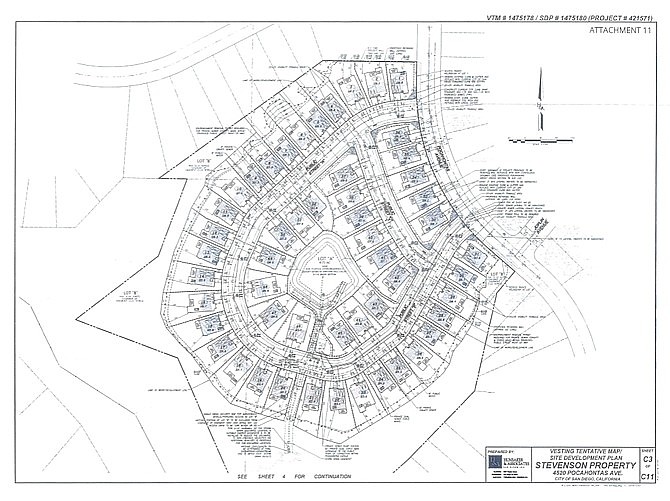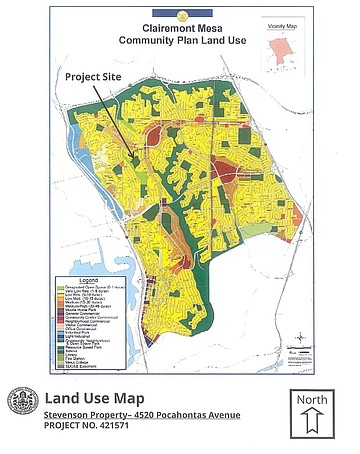 Facebook
Facebook
 X
X
 Instagram
Instagram
 TikTok
TikTok
 Youtube
Youtube

Fifty-two mini-mansions are planned for a recently demolished 17.5-acre elementary-school site (4520 Pocahontas Avenue). The new neighborhood (being sold as Tavara Ridge) of two-story homes will have two- to three-car garages with up to five bedrooms and four to five bathrooms.

At two community planning group meetings in 2015, concerns expressed included the architecture, density, size, water usage, landscaping, the planned wall to separate the development from the rest of the neighborhood, open park space, traffic, and parking.
One resident expressed concerns about the project not emulating the community, being that 99 percent of the neighborhood includes single-story homes of around 1500 square feet. In the nearly one-mile stretch of Pocahontas Avenue, most of the mid-century ranch-style homes are single-story, with only a handful of two-story homes located blocks away from the project site.
In regard to density, a June 2016 city staff report stated that the community plan allowed for 47 to 95 units to be built if the school was no longer needed.
Per Cynthia Reed-Porter from the San Diego Unified School District, the school site was declared unneeded in the late 1980s and was sold to Ryland Homes for $13.2 million in December 2014 to help the district's budgetary issues.

The private elementary school that had been renting the Pocahontas site since 1993 didn’t see it as unneeded. According to Horizon Christian Academy’s principal, Cathy Dobbs, another Clairemont school site they’ve been renting since the mid-1980s has also been sold by the school district. They have to vacate the school in June 2017 and are having trouble finding another site due to zoning issues.
Since purchasing the school site, Ryland Homes has merged with another builder, Standard Pacific, to form CalAtlantic Homes. They now tout themselves as the fourth largest homebuilder in the nation.
As far as traffic concerns, the city’s assessment report stated that the development would generate an estimated 520 trips per day, resulting in 236 less trips than the school. I asked the city if weekends, evenings, and school breaks were part of the calculation but never received a response.

Danielle Tocco with CalAtlantic said about parking, “Each home will include a full size two to three [car] garage and a full-depth driveway. Additionally, there will be street parking on both of our internal streets.” She also said that the development significantly exceeds the city’s parking requirements.
City documentation shows that a minimum of 104 off-street parking spaces are required. Tocco didn’t respond with the total number of planned spaces. She said that residents will have two entrances/exits both off of Pocahontas.

What CalAtlantic won’t be offering is affordable housing. Instead, the company has opted to pay a fee to the city. PJ FitzGerald, assistant deputy director from the city’s Development Services Department, confirmed the current fee structure. A chart shows the fee to opt out of providing affordable housing to be $9.36 per square foot for developments with ten or more units.
According to a city invoice, CalAtlantic paid $2.81 per square foot for three model homes to be built (9616 square feet x $2.81 = $27,020.96). The chart shows $2.81 as the rate for developments with three units. If the developer had been charged at the rate for developments with 10 or more units ($9.36), the fee would have been $90,005.76. I wasn’t able to ascertain the reason for the discrepancy before publication.
FitzGerald said that building permits for the remaining 49 units are under review and that all affordable-housing opt-out fees have to be paid before building permits are issued. Via the city’s fee structure, that should be close to $1.4 million. (If the rate is closer to what the model homes were charged at, it will be closer to $400,000.)
What percentage of developers chose to pay the fee in 2016 instead of providing affordable housing? For this answer, the city directed me to the San Diego Housing Commission.

Scott Marshall from the San Diego Housing Commission said between January to September 2016, the housing commission received $20.2 million in fees to forgo affordable housing. Numbers for the rest of 2016 have yet to be finalized.
According to Marshall, 20 developments committed to provide a total of 165 affordable rental housing units in 2016; 4 of these developments set aside 89 affordable units instead of paying the fee; 16 set aside 76 affordable units to take advantage of the density bonus program. The latter is a program that allows developers to build more units than zoned for if they provide affordable housing.
I asked the city, the housing commission, and Sandag which San Diego neighborhoods had the least affordable housing. I was referred to reports that promised to hold the answer, but as of publication I haven’t been able to definitively answer that question.

I asked what the city’s plans are to improve affordable housing in every area of San Diego — especially to address low-wage earners being able to afford to live where they work. I was referred to the mayor’s office.
Mayor Faulconer's press secretary, Craig Gustafson, said, “Mayor Faulconer will lay out his plans to address affordable housing and homelessness, among other priorities, in next week’s [January 12] State of the City address.”


Fifty-two mini-mansions are planned for a recently demolished 17.5-acre elementary-school site (4520 Pocahontas Avenue). The new neighborhood (being sold as Tavara Ridge) of two-story homes will have two- to three-car garages with up to five bedrooms and four to five bathrooms.

At two community planning group meetings in 2015, concerns expressed included the architecture, density, size, water usage, landscaping, the planned wall to separate the development from the rest of the neighborhood, open park space, traffic, and parking.
One resident expressed concerns about the project not emulating the community, being that 99 percent of the neighborhood includes single-story homes of around 1500 square feet. In the nearly one-mile stretch of Pocahontas Avenue, most of the mid-century ranch-style homes are single-story, with only a handful of two-story homes located blocks away from the project site.
In regard to density, a June 2016 city staff report stated that the community plan allowed for 47 to 95 units to be built if the school was no longer needed.
Per Cynthia Reed-Porter from the San Diego Unified School District, the school site was declared unneeded in the late 1980s and was sold to Ryland Homes for $13.2 million in December 2014 to help the district's budgetary issues.

The private elementary school that had been renting the Pocahontas site since 1993 didn’t see it as unneeded. According to Horizon Christian Academy’s principal, Cathy Dobbs, another Clairemont school site they’ve been renting since the mid-1980s has also been sold by the school district. They have to vacate the school in June 2017 and are having trouble finding another site due to zoning issues.
Since purchasing the school site, Ryland Homes has merged with another builder, Standard Pacific, to form CalAtlantic Homes. They now tout themselves as the fourth largest homebuilder in the nation.
As far as traffic concerns, the city’s assessment report stated that the development would generate an estimated 520 trips per day, resulting in 236 less trips than the school. I asked the city if weekends, evenings, and school breaks were part of the calculation but never received a response.

Danielle Tocco with CalAtlantic said about parking, “Each home will include a full size two to three [car] garage and a full-depth driveway. Additionally, there will be street parking on both of our internal streets.” She also said that the development significantly exceeds the city’s parking requirements.
City documentation shows that a minimum of 104 off-street parking spaces are required. Tocco didn’t respond with the total number of planned spaces. She said that residents will have two entrances/exits both off of Pocahontas.

What CalAtlantic won’t be offering is affordable housing. Instead, the company has opted to pay a fee to the city. PJ FitzGerald, assistant deputy director from the city’s Development Services Department, confirmed the current fee structure. A chart shows the fee to opt out of providing affordable housing to be $9.36 per square foot for developments with ten or more units.
According to a city invoice, CalAtlantic paid $2.81 per square foot for three model homes to be built (9616 square feet x $2.81 = $27,020.96). The chart shows $2.81 as the rate for developments with three units. If the developer had been charged at the rate for developments with 10 or more units ($9.36), the fee would have been $90,005.76. I wasn’t able to ascertain the reason for the discrepancy before publication.
FitzGerald said that building permits for the remaining 49 units are under review and that all affordable-housing opt-out fees have to be paid before building permits are issued. Via the city’s fee structure, that should be close to $1.4 million. (If the rate is closer to what the model homes were charged at, it will be closer to $400,000.)
What percentage of developers chose to pay the fee in 2016 instead of providing affordable housing? For this answer, the city directed me to the San Diego Housing Commission.

Scott Marshall from the San Diego Housing Commission said between January to September 2016, the housing commission received $20.2 million in fees to forgo affordable housing. Numbers for the rest of 2016 have yet to be finalized.
According to Marshall, 20 developments committed to provide a total of 165 affordable rental housing units in 2016; 4 of these developments set aside 89 affordable units instead of paying the fee; 16 set aside 76 affordable units to take advantage of the density bonus program. The latter is a program that allows developers to build more units than zoned for if they provide affordable housing.
I asked the city, the housing commission, and Sandag which San Diego neighborhoods had the least affordable housing. I was referred to reports that promised to hold the answer, but as of publication I haven’t been able to definitively answer that question.

I asked what the city’s plans are to improve affordable housing in every area of San Diego — especially to address low-wage earners being able to afford to live where they work. I was referred to the mayor’s office.
Mayor Faulconer's press secretary, Craig Gustafson, said, “Mayor Faulconer will lay out his plans to address affordable housing and homelessness, among other priorities, in next week’s [January 12] State of the City address.”
Comments